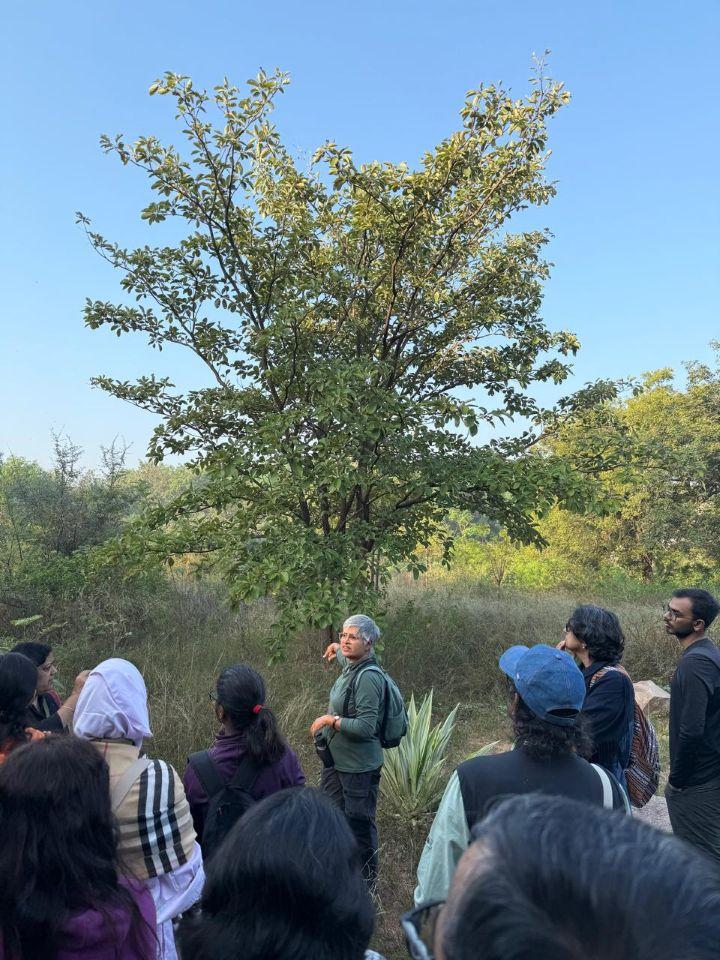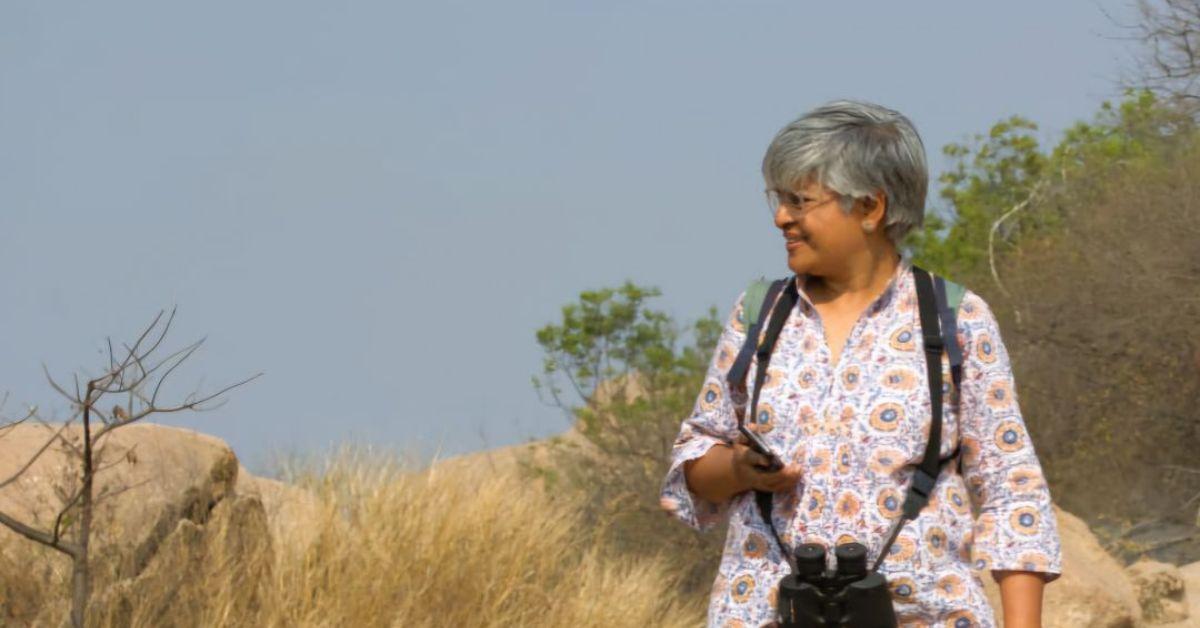Do tell us about yourself, where you are from, and your work.
I am Kobita Dass Kolli, an educator and independent researcher based in Hyderabad. I document the flora and small fauna of the Hyderabad region with a focus on the rocky outcrops. I share my findings on walks, talks and social media with an aim to inform, excite curiosity and encourage appreciation for local biodiversity, the organisms, and their habitats.
A friend and I have been conducting a weekly nature and gardening activity for fourth-class students at Vidyaranya School in Hyderabad for the past 22 years. I am a resource person for the World Wildlife Fund, Hyderabad, and lead walks and present to students from other institutions.
I am an intermittent illustrator. I have worked at Titan as a watch designer for 6 years and freelanced in watch and identity design for 4 years. I hold a bachelor’s degree in botany, a master’s in plant sciences, and an MPhil in plant physiology.
What excites you about the natural world?
I find wonder everywhere in the natural world, especially in the challenging landscape and habitats of the region where I live. Being in nature engages all my senses, and learning is abundant and ceaseless. I enjoy admiring and documenting the small flora and grasses of the rocky habitats. I am most excited when I find uncommon species such as Ceropegia, ground orchids, ferns, squills and insectivorous plants, or a new species record for the area.
The aesthetics of form, patterns and function of every organism is unique but with a purpose, and that never ceases to fascinate. Understanding survival strategies and the myriad interactions between the organisms in their habitats, is exciting, while the quietness in observation is meditative. All these aspects are immensely satisfying and urge me to continue to engage with the natural world, both in the field and in researching and reading.

When and how did you get interested in bird/nature education?
When my daughter joined Vidyaranya School, Hyderabad, I met co-parent Sadhana Ramchander, who had initiated a gardening activity the previous year for her older daughter’s fourth grade. She asked whether I would like to join her and take it forward since I had mentioned I enjoyed gardening. We soon found that we had no choice but to explain aspects of nature while being outdoors and gardening.
With my interest in the natural world, I was able to satisfy the children’s curiosity, and the urge to pursue documenting and learning about local species took over. Hence it has now become a class about gardening and nature. I was also familiar with cultivated trees and plants, so we started tree walks on the school campus. That is how I came to realise that I enjoyed sharing my love and interest in nature with children as well as adults.
What do you hope to achieve through your education work?
I would like to connect children and adults to the natural world, particularly plants and their amazing lives despite them being rooted to one spot. I want people to know that we humans are an entangled part of the whole and every organism should be acknowledged for itself. I want them to understand and appreciate it with a sense of wonder, and fall in love with it.
At the same time, I would like to be able to convey an objective understanding which is as important as an emotional connection. The fact that nature continues to inspire the humanities, arts, science and technology, and aids in our wellbeing is a reason for humanity to comprehend its resilience, vulnerabilities, and tread lightly. I want people to know this.

Why do you believe it is important for children to learn about birds or connect with nature?
Nature is the best educator and educational aid. A sound relationship with nature may help children stay grounded, encourage sustainable choices, build resilience, and provide inspiration as well as succour always.
What tools or resources have helped you in teaching about birds? Can you describe an approach that has worked exceptionally well for you?
Being in the field is one of the best ways to engage and make memorable connections. There is nothing like a firsthand bug quest accompanied by interesting facts. Seeing antlion larval pit traps and learning about the larval behaviour is always amazing. Games are a fun way to learn too. We have used the Early Bird flashcards and the web-of-life game to remarkable success as well as a couple of amusing, physically active games, including a tree hunt.
Show and tell activities work as well, such as demonstrating ways by which plants travel using seeds or showing the ingenious or simple items humans make using natural materials. Models are ideal tools. I made a tree model to describe why translocation is not an option for large old trees, a simple and highly effective visual aid that requires almost no explanation. I plan to introduce Vidyaranya students to nature journaling in the coming academic year.

Have you encountered a significant challenge as a bird/nature educator, how did you overcome it?
One major challenge I face is to change the perception that tree plantations must be made in all open areas irrespective of whether the habitat is a grassland, marsh, riverbed, or savannah and that the landscape ought to remain green throughout the year. It is a challenge to convince people that our region of seasonal browns, thorn scrub and deciduous trees is biodiverse, important and merits conserving.
The idea needs to be understood in all its complexities with all the nuances and often that is where I lose people’s willingness to understand. I find that whenever there is a hard pill to swallow, it goes down better when a couple of others pitch in and share their perspectives.
Another challenge is the difficulty to rouse enthusiasm for native flora. I need to dig deep to find stories that resonate, and I must constantly work to improve my storytelling. I have learnt to be patient when dealing with strong, unscientific, uninformed, or unreasonable opinions but I still need to work on it.
Do share any memorable moment or experience you have had in teaching kids about birds/nature. Can you recall any insightful instance that shaped your perspective?
Once on a nature walk in the conservation zone of a local national park I was quite sure of not encountering snakes, so I walked off the path in search of a noteworthy fallen seed pod of a particular tree which I soon located and triumphantly brought to show the participants.
Coming through without a snake scare reinforced my perception that snakes will typically move away from disturbance, the reason I had not met with more than two safe encounters in the many years of roaming the scrub. But no more than a hundred meters ahead, someone called out ‘snake’!
There was a beautifully camouflaged Russel’s viper, sunning itself, lying coiled, on one side of the path and I had just walked less than half a meter by it. When I turned to look it was silently slithering away into the undergrowth. I was extremely relieved that we had not faced any regrettable incident that day in the presence of more than fifty participants, young and old.
Although I knew, I had not given enough thought to species specific behaviour of snakes until then. That was an unforgettable lesson. I refreshed my knowledge about the ‘big four,’ all of which are present in our landscape, and since then I step in the wild more alert and aware.

Have you noticed any changes in your learners after they received exposure to birds and nature-based learning? If yes, what are they? If not, why do you think that is?
The gardening and nature activity class is a 40-minute period once a week and I have noticed children becoming less distracted and more engaged as the academic year progresses. Children become more tolerant of insects and stop squealing and squirming, and all imagined allergies to bugs, soil, etc., are forgotten.
I believe a consistent, pragmatic, and objective approach to nature education accompanied by passion, and thoughtful answers to queries allays fears and prejudices, leading children to form a healthy relationship with the natural world. Adults are overjoyed to renew their connection or forge new connections with nature around them.
What message would you have for your fellow educators, or somebody starting out in their nature education journey?
I would encourage nature educators to share their joy of nature with children and adults alike. Indicate that it is a shared adventure, and everyone is learning together. Strive to get facts right but never hesitate to admit a mistake or to not know. Anecdotes and short stories and a sense of humour will always have a lasting impact.
As often as pose questions and seek answers, it is always engaging to have people think out-of-the-box. Encourage a sense of shared responsibility in which everybody is entrusted to care for nature with understanding and respect. Do not give up because nature education is personally extremely rewarding.

